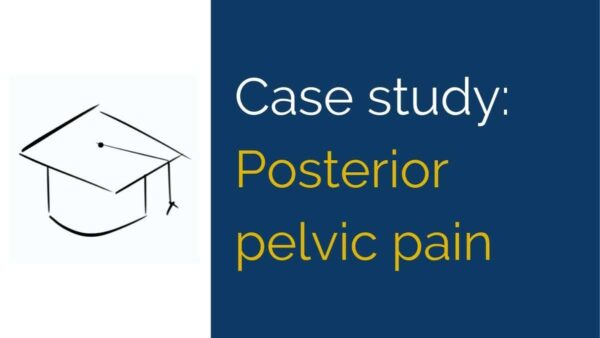Background – Posterior pelvic pain
This case presents diagnostic difficulties relating to insidious onset posterior pelvic pain. It tests knowledge of musculoskeletal and non-musculoskeletal diagnoses and interpretation of physical examination findings.
Minimum Level
Physiotherapist with 3+ years experience
History
Mary, an active 28 year old woman, presents with a 10 week history of insidious onset posterior pelvic pain.
The pain is described as central, around the lower sacrum and coccyx, but refers bilaterally around 10cm away from midline.
Given this description, what potential pathologies would you begin to consider?
Which pathologies are much less likely given the distribution of symptoms?
There has been one previous episode of posterior pelvic pain around 8 months ago. It lasts for one week and was not associated with any other symptoms such as abdominal discomfort or irregularities in bowel/bladder function.
How does this information affect your diagnostic reasoning?
The posterior pelvic pain is more noticeable when sitting on hard chairs and after prolonged sitting with knees to chest.
The pain is described as a dull ache that increases in intensity but there’s no sharp pain.
Walking doesn’t aggravate or ease symptoms.
Discuss these three pieces of information and how they may fit with your current provisional diagnosis.
The symptoms are generally feeling better in the morning and seem to worsen as the day goes on, particularly if there is more sitting than usual. There is no night pain.
Explain the diagnostic value of this description of 24 hour pain behaviour.
Mary describes her menstrual cycle as regular and has not noticed anything abnormal with her periods over the past few years.
Mary states that she does not have a family history of any reproductive or digestive tract issues.
How does this information affect your list of diagnostic probabilities?
Provide a list of your top 3 provisional diagnoses at this stage.
What are you looking to achieve with your physical examination?
Physical Examination
Mary stands with a balanced relaxed posture and reports no symptoms in that position.
Performing a 1/4 depth single leg squat causes mild discomfort across the symptomatic area at the lowest point of the movement.
Performing a full depth bodyweight squat does not cause any symptoms.
Hopping on the spot produces a dull posterior pelvic pain across the area as well as a residual ache after the exercise has ceased.
Discuss how these findings match your list of provisional diagnoses.
Hip and lumbar range is well preserved and asymptomatic.
SIJ testing is unremarkable.
Explain your approach to SIJ testing and the research support for SIJ tests generally.
Palpation of SIJ is painful across the distal half of the joint line bilaterally and reproduces the same posterior pelvic pain as Mary’s presenting symptoms.
Does this finding reduce your concern regarding non-musculoskeletal diagnoses?
Provisional Diagnosis
Provide your most likely diagnosis at this point and justify your selection with reasoning from the history and physical examination information.
Provide 1-2 differential diagnosis/es at this point and justify them with reasoning from the history and physical examination information.
Further Testing
Would you order any imaging at this point? If so, which type of image would you request?
If not now, when would you order it and what would be the trigger to initiate the request?
Management Planning
Design a management approach that would address your provisional diagnosis as well as assist in excluding or confirming your differential diagnoses.
Justify the inclusion of each aspect of your plan (for example, this may included in your reasoning for considering mobilisations).
Like to continue the conversation? Head over to our Facebook page.

